Raphaël Coutin

Bygg Design VOF
Leidingstraat 17A
5617AJ Eindhoven
The Netherlands
contact@raphaelcoutin.com
NL. +31 619 438 530
LINKS
Bygg Architecture & Design
co-founder
Fictional collective_
co-founder
Plug-in-City_
board member_communication
Since 2015, Raphaël Coutin has worked at the intersection of design and architecture as an independent studio. Trained in sculpture at ENSAAMA in Paris and later in social design at Design Academy Eindhoven, Raphael develops his practices by collaborating with diverse creative studios, institutions and schools, exploring the creative world of design.
Raphael seeks to create a dialogue between his design, its territory and concept, based on the premise that projects always take place in a specific social and geographical context. He sees design as a tool for building connections and for transforming ideas, ideals, vision or reflection into an understandable, tangible outcome. Maquettes, drawings, 3d models, animation and scale prototypes are just some of the approaches Raphael uses to develop projects in to a specific reality.
Since 2020, Raphael is co-owner of the dsign studio Bygg Architecture & Design based at Plug-in City in Eindhoven.
Raphael seeks to create a dialogue between his design, its territory and concept, based on the premise that projects always take place in a specific social and geographical context. He sees design as a tool for building connections and for transforming ideas, ideals, vision or reflection into an understandable, tangible outcome. Maquettes, drawings, 3d models, animation and scale prototypes are just some of the approaches Raphael uses to develop projects in to a specific reality.
Since 2020, Raphael is co-owner of the dsign studio Bygg Architecture & Design based at Plug-in City in Eindhoven.
Near Earth Human

The story of asteroid 2017 YE5 starts on December 21,2017 when French astronomer Claudine Rinner discovered the object using the Marocco Oukaimeden Sky Survey (MOSS).
On 21 June 2018 at 20:53 UTC, 2017 YE5 passed at its closest to earth: 15,52 lunar distances. On that date, observed by the monostatic Goldstone Solar System Radar in California, the images revealed that 2017 YE5 is a binary pair of asteroids, so composed of two bodies, 2005 UP156 and 2017 YE5. These two bodies of approximately 0.9km in diameter together are gravitating with each other along their orbit around the sun. To date, only four equal mass binary asteroids have been discovered among the near-Earth population which makes this phenomenon very very rare!
One of the theory explains that the asteroids could have started as two separate entities with similar orbit and locations. First looking at each other, getting closer, joining orbits until they would have become gravitationally bound, and begun to dance with one and another.
On 21 June 2018 at 20:53 UTC, 2017 YE5 passed at its closest to earth: 15,52 lunar distances. On that date, observed by the monostatic Goldstone Solar System Radar in California, the images revealed that 2017 YE5 is a binary pair of asteroids, so composed of two bodies, 2005 UP156 and 2017 YE5. These two bodies of approximately 0.9km in diameter together are gravitating with each other along their orbit around the sun. To date, only four equal mass binary asteroids have been discovered among the near-Earth population which makes this phenomenon very very rare!
One of the theory explains that the asteroids could have started as two separate entities with similar orbit and locations. First looking at each other, getting closer, joining orbits until they would have become gravitationally bound, and begun to dance with one and another.
An asteroid
![]()
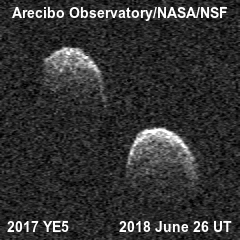

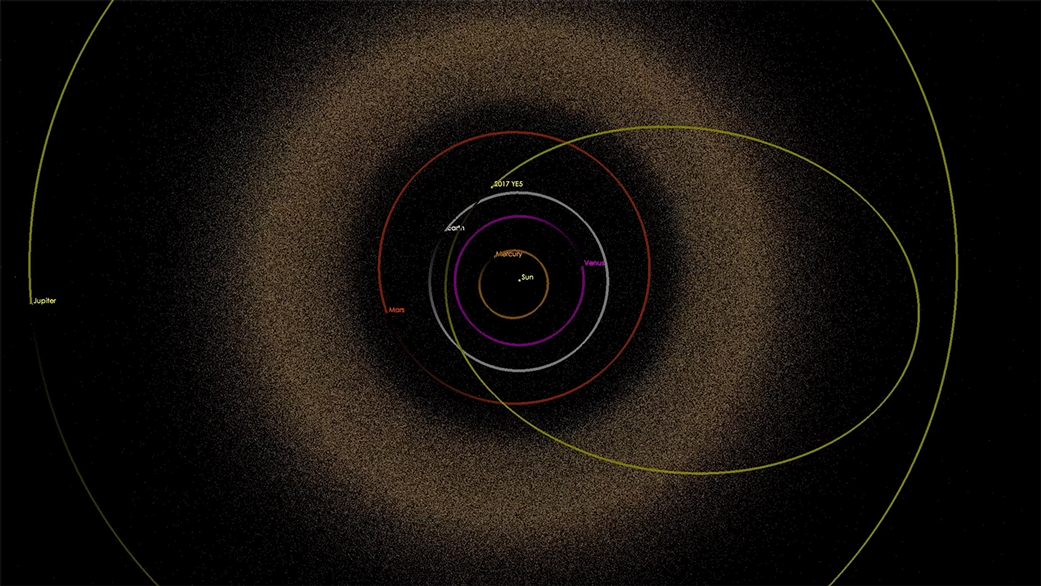
This love story is an introduction to our project, we want to draw life as a dance. We want to bring our attention to the motion of things, from the stars to the movement of human here on planet Earth, and question the movement ot the post Anthropocene world.
Hundreds of telescopes are every night observing these near-earth objects (NEOs), making sure none of them is getting to close to us. We are classifying all these extra-terrestrial bodies in other terms we are drawing the motion of our near space. This all movement in space can be seen as a beautiful yet dangerous dance around the sun, placing us as human, on our little globe, part of this. Great forces, gravities, black holes influence this movement, give the tempo, accelerate or slow down all bodies around.
We too behave in an organized chaos, sometimes with elegance sometimes with clash and crashes. We all have in mind these fascinating accelerated images of human movement, dictated by traffic lights, result of our complex organization. Movement is part of life, but can also become a threat. We put a large effort into studying NEOs not only for understanding our planet better or by fascination but also by fear, trying to foresee potential collision that might have disastrous repercussion.
Furthermore on a human scale we also see our fear of human movement, from migration to disease spread that we are experiencing right now.
Hundreds of telescopes are every night observing these near-earth objects (NEOs), making sure none of them is getting to close to us. We are classifying all these extra-terrestrial bodies in other terms we are drawing the motion of our near space. This all movement in space can be seen as a beautiful yet dangerous dance around the sun, placing us as human, on our little globe, part of this. Great forces, gravities, black holes influence this movement, give the tempo, accelerate or slow down all bodies around.
We too behave in an organized chaos, sometimes with elegance sometimes with clash and crashes. We all have in mind these fascinating accelerated images of human movement, dictated by traffic lights, result of our complex organization. Movement is part of life, but can also become a threat. We put a large effort into studying NEOs not only for understanding our planet better or by fascination but also by fear, trying to foresee potential collision that might have disastrous repercussion.
Furthermore on a human scale we also see our fear of human movement, from migration to disease spread that we are experiencing right now.
A movement
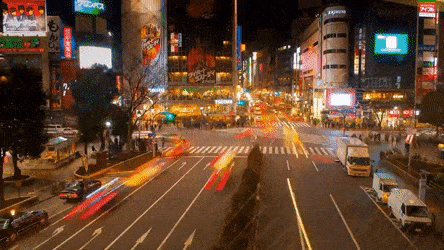
In 2020, an external factor came to slow the human cadence,brutally limiting the movement of humans, the street became empty, skies clear of planes and it gave us the time to look at the stars.
This moment also give a good opportunity to talk about movement and dance, we want to ask ourselves one question: what is the tempo of human in a post Anthropocene world.
By looking beyond our planet we can observe the unstoppable motion of matter, we are fundamentally always in motion, alone, with someone or/andas a collective. But we can question the velocity, is there a critical point?
The industrialization of the worlds for the last centuries has brought unprecedented progress for human life and contributed to an acceleration of movement and interaction. The collateral damages of this are very well know and pushes us to project more than ever the world of tomorrow and to break this pattern of constant acceleration.Why not looking at the stars and find inspiration, many asteroids don’t have the perfect balance as 2005 UP156 and 2017 YE5 and crashes into each other leaving dust behind. What parameters it took for them to bound?
As a reflection point for us, what parameter it takes for post Anthropocene human to bound with Earth and enter in a dance, metaphorically?
This moment also give a good opportunity to talk about movement and dance, we want to ask ourselves one question: what is the tempo of human in a post Anthropocene world.
By looking beyond our planet we can observe the unstoppable motion of matter, we are fundamentally always in motion, alone, with someone or/andas a collective. But we can question the velocity, is there a critical point?
The industrialization of the worlds for the last centuries has brought unprecedented progress for human life and contributed to an acceleration of movement and interaction. The collateral damages of this are very well know and pushes us to project more than ever the world of tomorrow and to break this pattern of constant acceleration.Why not looking at the stars and find inspiration, many asteroids don’t have the perfect balance as 2005 UP156 and 2017 YE5 and crashes into each other leaving dust behind. What parameters it took for them to bound?
As a reflection point for us, what parameter it takes for post Anthropocene human to bound with Earth and enter in a dance, metaphorically?
We are Human
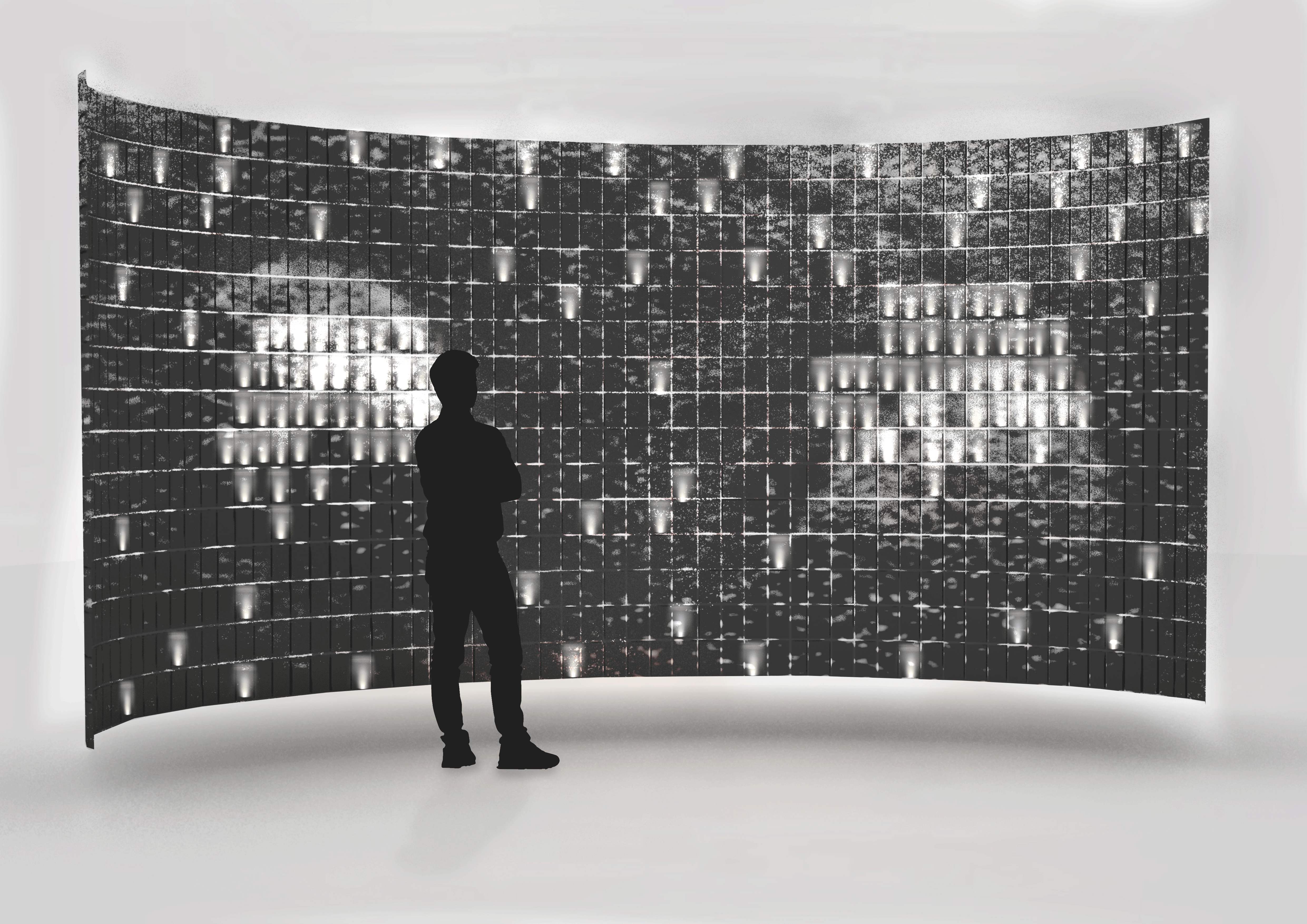
To reflect upon this topic we propose an installation for STRP festival that put human cadence in perspective and in connection with the cadence of the universe.
Offline
We envision a curved installation composed of a dozen piecesof paper. This installation will be a visualization of various temporality byresponding to different momentum programmed within the hours, weeks and years - Which put us into the asteroid perspective.
But first let’s describe those pieces of papers, they will be thick textured paper, embossed, representing the asteroids texture. Dark, dry, rough but yet precise and delicate. Each individual piece will beassociated with a know NEOs (from the NASA database) and named upon it. They willdisplay LEDs enlightening the textured surface. All together on the wall, thelight will animate the story of our two asteroids, illustrating their dance.
We will propose the visitors to take one of the asteroids along and once away from the other it will follow two parameters visible through thelighting:
1. The light will be given a base pattern, a behavior base on their rotation period obeserved by the Nasa. Much like a heartbeat, a sigular identity
2. The light will change with the surrounding of others. Either accelerate and switching off for a moment ( a crash) OR starts synchronizing (a dance) with the other(s) if they recognize each other.
Each visitor will carry along a piece of the ‘collective’ and bring it with them as a constant remembrance of asteroid’s movement. But it will only dance again if getting closer to another one.
Offline
We envision a curved installation composed of a dozen piecesof paper. This installation will be a visualization of various temporality byresponding to different momentum programmed within the hours, weeks and years - Which put us into the asteroid perspective.
But first let’s describe those pieces of papers, they will be thick textured paper, embossed, representing the asteroids texture. Dark, dry, rough but yet precise and delicate. Each individual piece will beassociated with a know NEOs (from the NASA database) and named upon it. They willdisplay LEDs enlightening the textured surface. All together on the wall, thelight will animate the story of our two asteroids, illustrating their dance.
We will propose the visitors to take one of the asteroids along and once away from the other it will follow two parameters visible through thelighting:
1. The light will be given a base pattern, a behavior base on their rotation period obeserved by the Nasa. Much like a heartbeat, a sigular identity
2. The light will change with the surrounding of others. Either accelerate and switching off for a moment ( a crash) OR starts synchronizing (a dance) with the other(s) if they recognize each other.
Each visitor will carry along a piece of the ‘collective’ and bring it with them as a constant remembrance of asteroid’s movement. But it will only dance again if getting closer to another one.
The installation
![]()
![]()


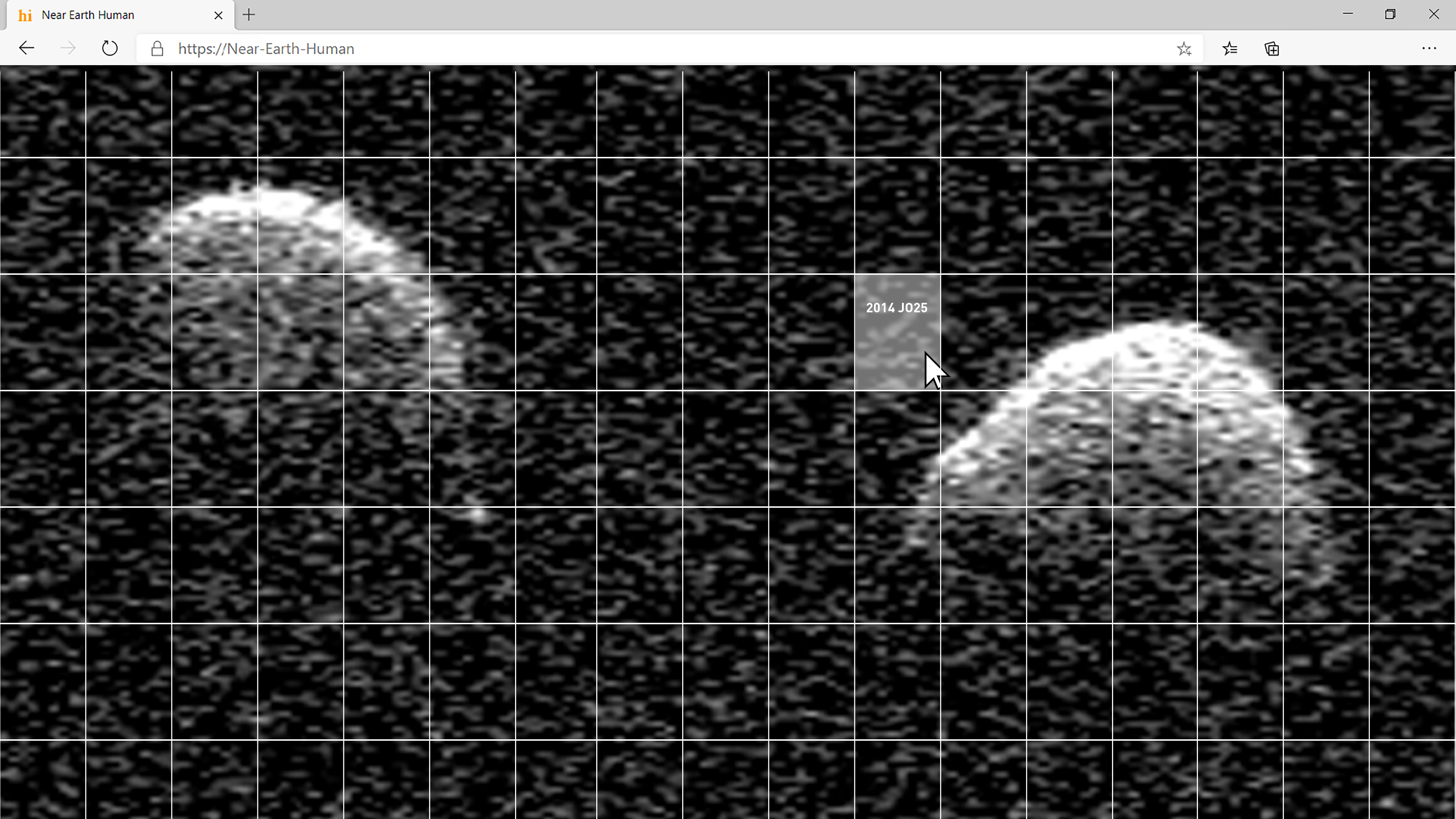

Online
The online visitor will connect to a dedicated web page to visualize the wall of asteroids, lightening up on the same pattern as in the exhibition. The story will be explained within this animation home page.
You will have the possibility of clicking on each piece and by doing so it will create a blink instantaneously visible in the real installation as a connection with the offline visitor. The click will bring the online visitor on the page of the chosen asteroid with all the specific data.
For the online visitor is mainly about data visualization and proposing another approach of seeing the asteroids. We also want to offer the possibility of ordering one or a few pieces. Each piece will be made in double, one of the reason is to keep the installation complete during the whole duration of the event and the other will be sent to an online buyer after the event.
The online visitor will connect to a dedicated web page to visualize the wall of asteroids, lightening up on the same pattern as in the exhibition. The story will be explained within this animation home page.
You will have the possibility of clicking on each piece and by doing so it will create a blink instantaneously visible in the real installation as a connection with the offline visitor. The click will bring the online visitor on the page of the chosen asteroid with all the specific data.
For the online visitor is mainly about data visualization and proposing another approach of seeing the asteroids. We also want to offer the possibility of ordering one or a few pieces. Each piece will be made in double, one of the reason is to keep the installation complete during the whole duration of the event and the other will be sent to an online buyer after the event.
We are a collective of 3 designers Ivo Hulskamp & Raphael Coutin (bygg design)
with the help of Tomas Gecevicius
Ivo Hulskamp is a product designer and artist. He combines conceptual thinking with advanced productions skills developing conceptual lighting installations, design objects and industrial products.
He successfully finished a degree in mechanical engineering, a bachelor in Product Design at the University of the Arts Utrecht (HKU) and a Master Public Space Design at the MAHKU in 2009. He now lives and works in Eindhoven, cofounder of Bygg Design V.O.F since 2020
He enrolled for a course in mechanical engineering in order to be “able to make anything” and after completion he found a job as a machine builder. He quickly found that the industrial environment was conceptually not satisfying and wanted to make more autonomous work.
Raphaël Coutin is a social designer. He works at the intersection of design and architecture. Trained in sculpture at ENSAAMA in Paris and later in social design at Design Academy Eindhoven in 2014. Raphael develops his practices by collaborating with diverse creative studios, institutions and schools, exploring the creative world of design. Cofounder of Bygg design V.O.F since 2020
Raphael seeks to create a dialogue between his design, its territory and concept, based on the premise that projects always take place in a specific social and geographical context. He sees design as a tool for building connections and for transforming ideas, ideals, vision or reflection into an understandable, tangible outcome. Maquettes, drawings, 3d models, animation and scale prototypes are just some of the approaches Raphael uses to develop projects in to a specific reality.
Tomas Gecevičius is an industrial designer with a passion for technology. With a focus on the Internet of Things field he can create connected interactive physical or digital solutions.
Tomas finished a bachelor of Engineering Design and Industrial Design in Kaunas University of Technology in Lithuania and is now completing his master studies of Industrial design in Eindhoven University of Technology.
His design approach is user-centered design from the interaction side. Tomas enjoys creating projects and seeing them to “come alive”. To emphasize the aliveness in his ideas, he incorporates the light, physical movement, or motion graphics.
Ivo Hulskamp is a product designer and artist. He combines conceptual thinking with advanced productions skills developing conceptual lighting installations, design objects and industrial products.
He successfully finished a degree in mechanical engineering, a bachelor in Product Design at the University of the Arts Utrecht (HKU) and a Master Public Space Design at the MAHKU in 2009. He now lives and works in Eindhoven, cofounder of Bygg Design V.O.F since 2020
He enrolled for a course in mechanical engineering in order to be “able to make anything” and after completion he found a job as a machine builder. He quickly found that the industrial environment was conceptually not satisfying and wanted to make more autonomous work.
Raphaël Coutin is a social designer. He works at the intersection of design and architecture. Trained in sculpture at ENSAAMA in Paris and later in social design at Design Academy Eindhoven in 2014. Raphael develops his practices by collaborating with diverse creative studios, institutions and schools, exploring the creative world of design. Cofounder of Bygg design V.O.F since 2020
Raphael seeks to create a dialogue between his design, its territory and concept, based on the premise that projects always take place in a specific social and geographical context. He sees design as a tool for building connections and for transforming ideas, ideals, vision or reflection into an understandable, tangible outcome. Maquettes, drawings, 3d models, animation and scale prototypes are just some of the approaches Raphael uses to develop projects in to a specific reality.
Tomas Gecevičius is an industrial designer with a passion for technology. With a focus on the Internet of Things field he can create connected interactive physical or digital solutions.
Tomas finished a bachelor of Engineering Design and Industrial Design in Kaunas University of Technology in Lithuania and is now completing his master studies of Industrial design in Eindhoven University of Technology.
His design approach is user-centered design from the interaction side. Tomas enjoys creating projects and seeing them to “come alive”. To emphasize the aliveness in his ideas, he incorporates the light, physical movement, or motion graphics.
Wo we are









Savonarola Collection
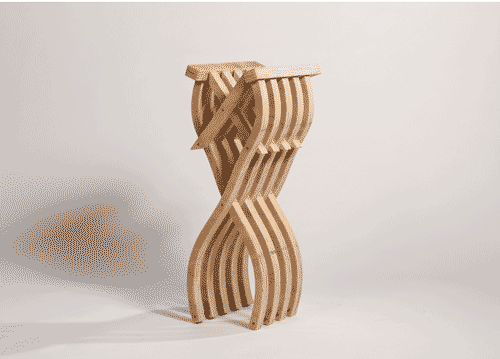

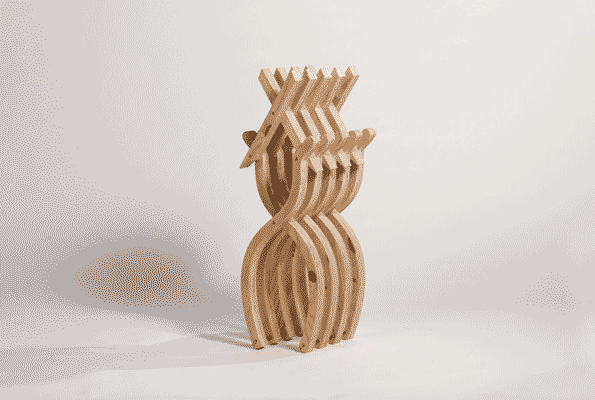
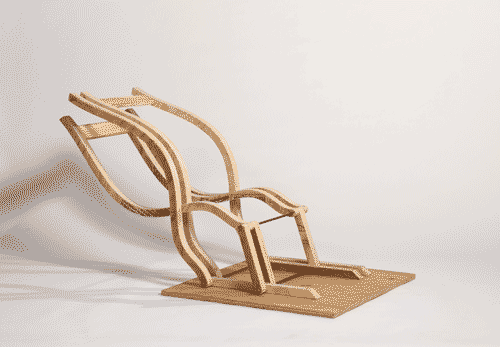








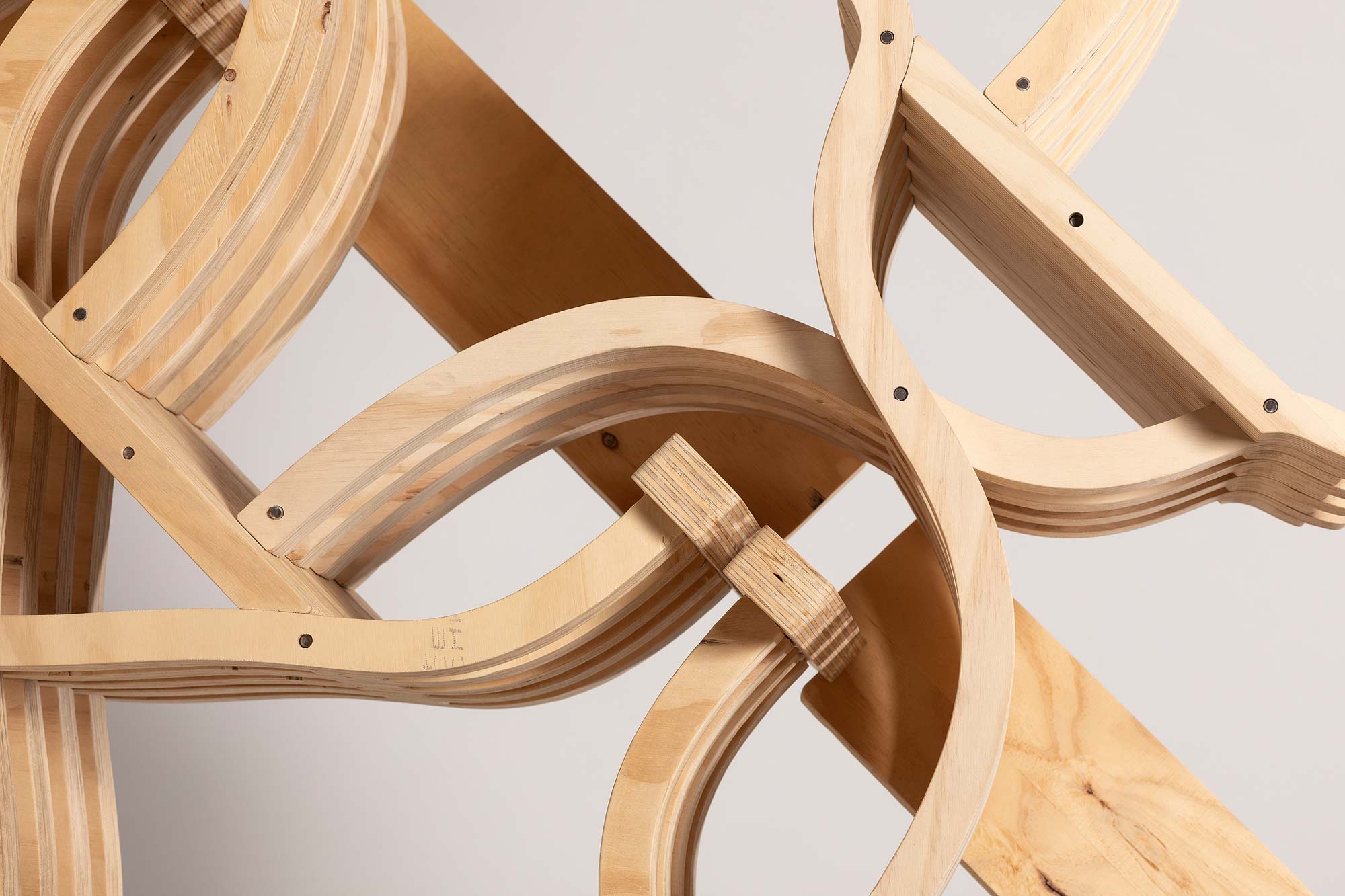
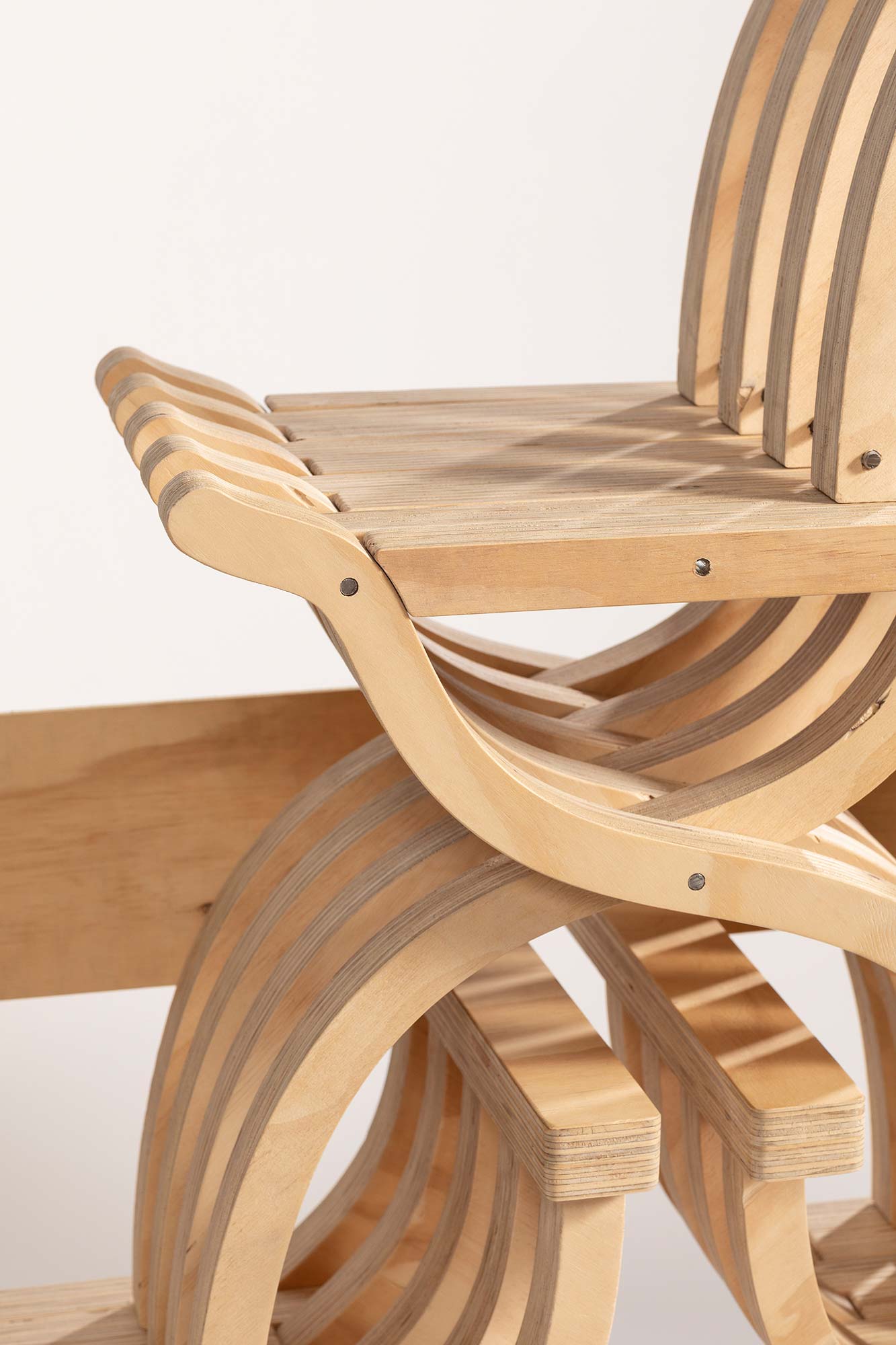

Design & Production/ Bygg Architecture & Design: Raphaël Coutin, Ivo Hulskamp
Special thanks to Corradino Garofalo
Year/ 2022
Status/ built
Client/ Springplank
This collection is a response to a very practical problem and is inspired by a childhood memory.We designed the furniture as part of the coffee place: Bakkie 040 on Strijp-S, Eindhoven.
The materials at our disposal for the interior work and the furniture were the leftover from an exhibition: Timber wood and pine plywood, ideal for building and plating interior walls. Once the large pieces were cut to size we ended up with a workshop full of cut out and smaller pieces difficult use. A good trick for using leftovers is to make small 'standard' parts out of them, thanks to our CNC we could cut all the parts for our chairs from the pieces lying around the workshop.
As a kid, Raphael remembers his father always reading from an antique chair, dark wood sculpted with two lion's heads on the armrest. Strangely fordable, they looked like a portable throne, giving you a straight and alert posture while seated.
The design originated in ancient Rome, the X-shaped chair, used by lords on the battlefield or at the colosseum, sometimes inlaid with ivory or metal, with leather seats or cushions. Over the century the design has been transformed in many ways, from a 4 legs chair to multiple wooden slats overlapping but always keeping their ornaments.
This chair took several names, Curule - Dante chair - Luther chair, and in the 19th century Savonarola chair. The name was given from the 15th-century Italian Dominican priest Girolamo Savonarola. Savonarola preached against the excesses of people, denounced clerical corruption and luxurious lifestyle, predicted the Last Days and he organized bonfires to publicly burn thousands of items. Ironically his name was given to a thing that he hated the most a chair full of ornaments, a symbol of social status and luxury.
Here we are playing with this history, designing a Savonarola chair, naked of ornaments, giving a lord's posture to every user. Democratizing its social status while removing the feudal symbolism in the ornament. Is it a statement? Probably not, but we like putting it down there!
The materials at our disposal for the interior work and the furniture were the leftover from an exhibition: Timber wood and pine plywood, ideal for building and plating interior walls. Once the large pieces were cut to size we ended up with a workshop full of cut out and smaller pieces difficult use. A good trick for using leftovers is to make small 'standard' parts out of them, thanks to our CNC we could cut all the parts for our chairs from the pieces lying around the workshop.
As a kid, Raphael remembers his father always reading from an antique chair, dark wood sculpted with two lion's heads on the armrest. Strangely fordable, they looked like a portable throne, giving you a straight and alert posture while seated.
The design originated in ancient Rome, the X-shaped chair, used by lords on the battlefield or at the colosseum, sometimes inlaid with ivory or metal, with leather seats or cushions. Over the century the design has been transformed in many ways, from a 4 legs chair to multiple wooden slats overlapping but always keeping their ornaments.
This chair took several names, Curule - Dante chair - Luther chair, and in the 19th century Savonarola chair. The name was given from the 15th-century Italian Dominican priest Girolamo Savonarola. Savonarola preached against the excesses of people, denounced clerical corruption and luxurious lifestyle, predicted the Last Days and he organized bonfires to publicly burn thousands of items. Ironically his name was given to a thing that he hated the most a chair full of ornaments, a symbol of social status and luxury.
Here we are playing with this history, designing a Savonarola chair, naked of ornaments, giving a lord's posture to every user. Democratizing its social status while removing the feudal symbolism in the ornament. Is it a statement? Probably not, but we like putting it down there!
CD-one
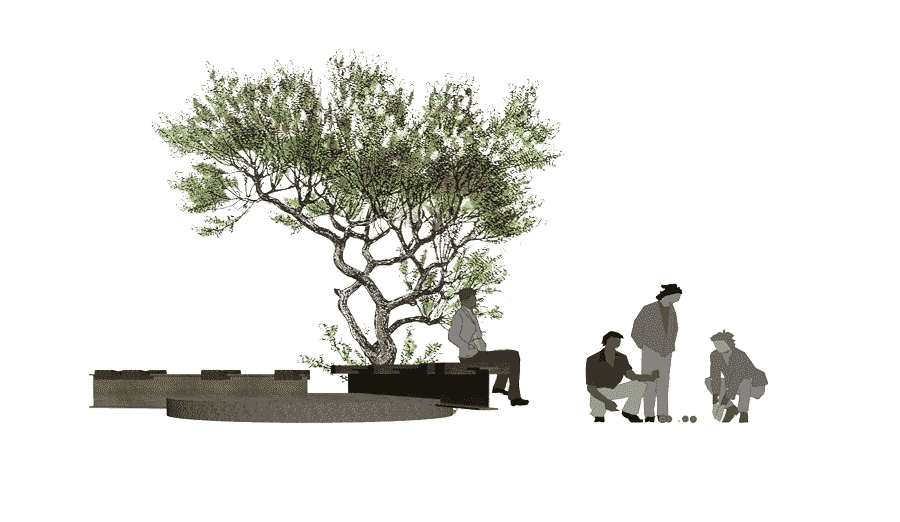

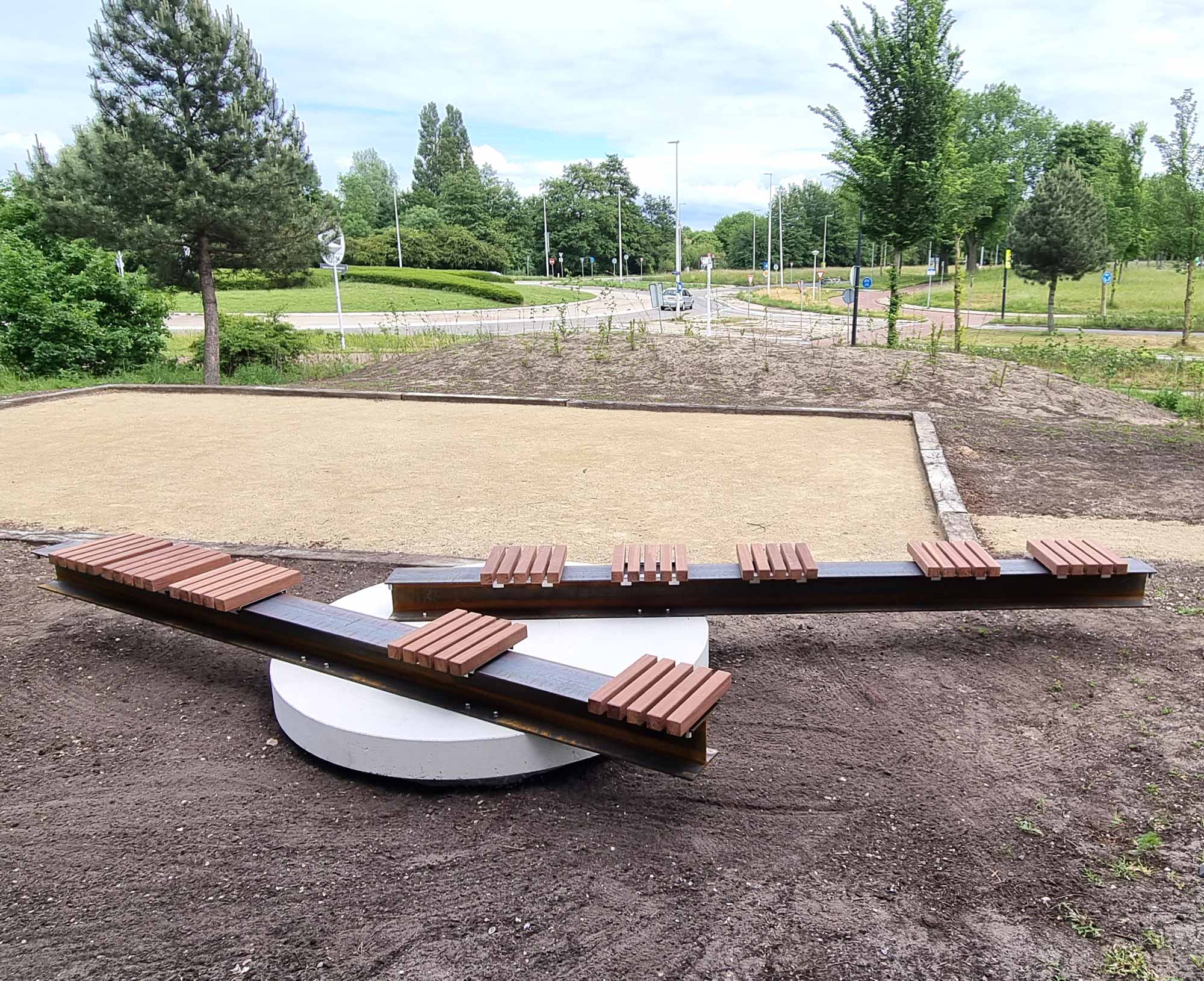
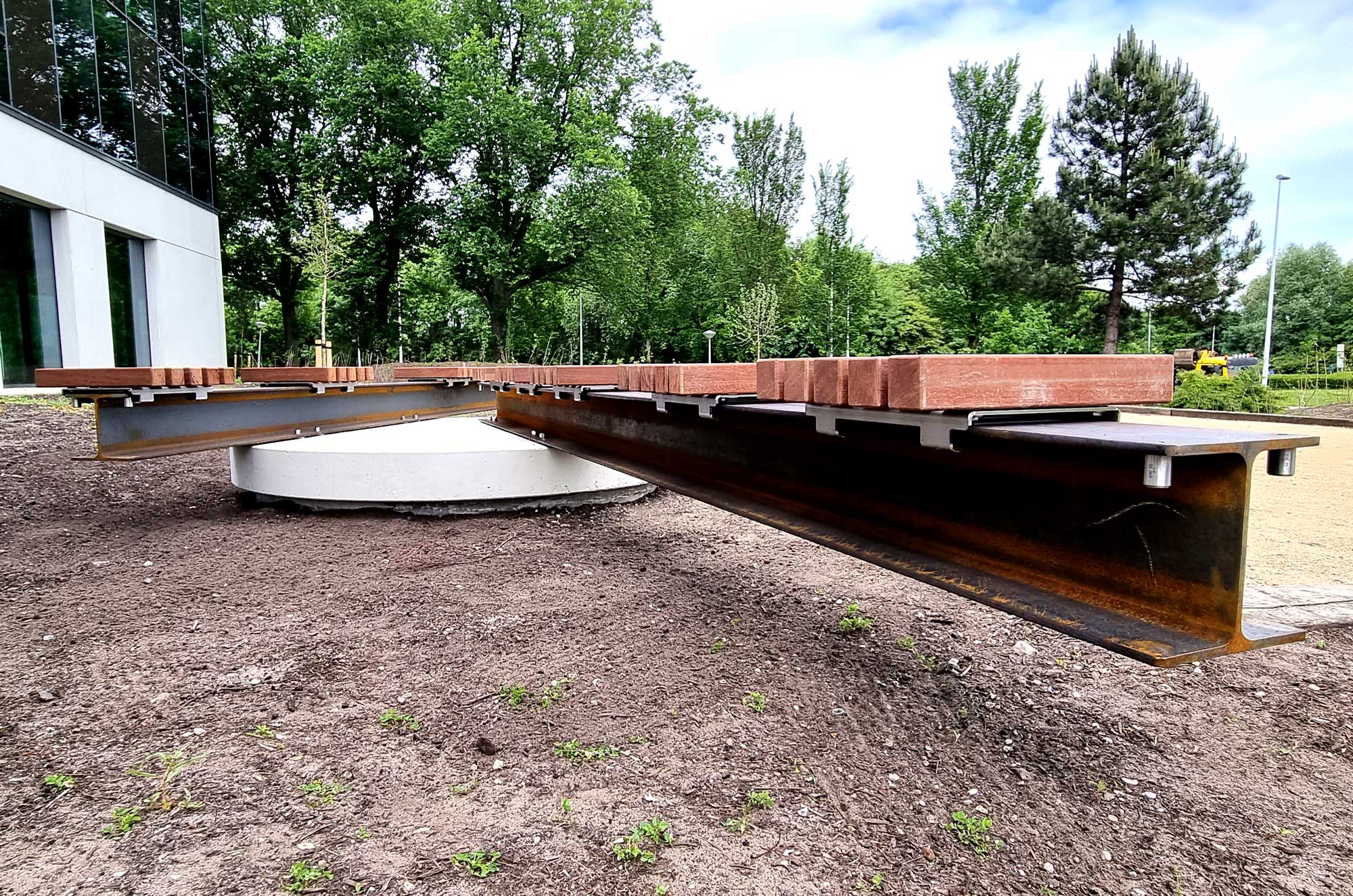
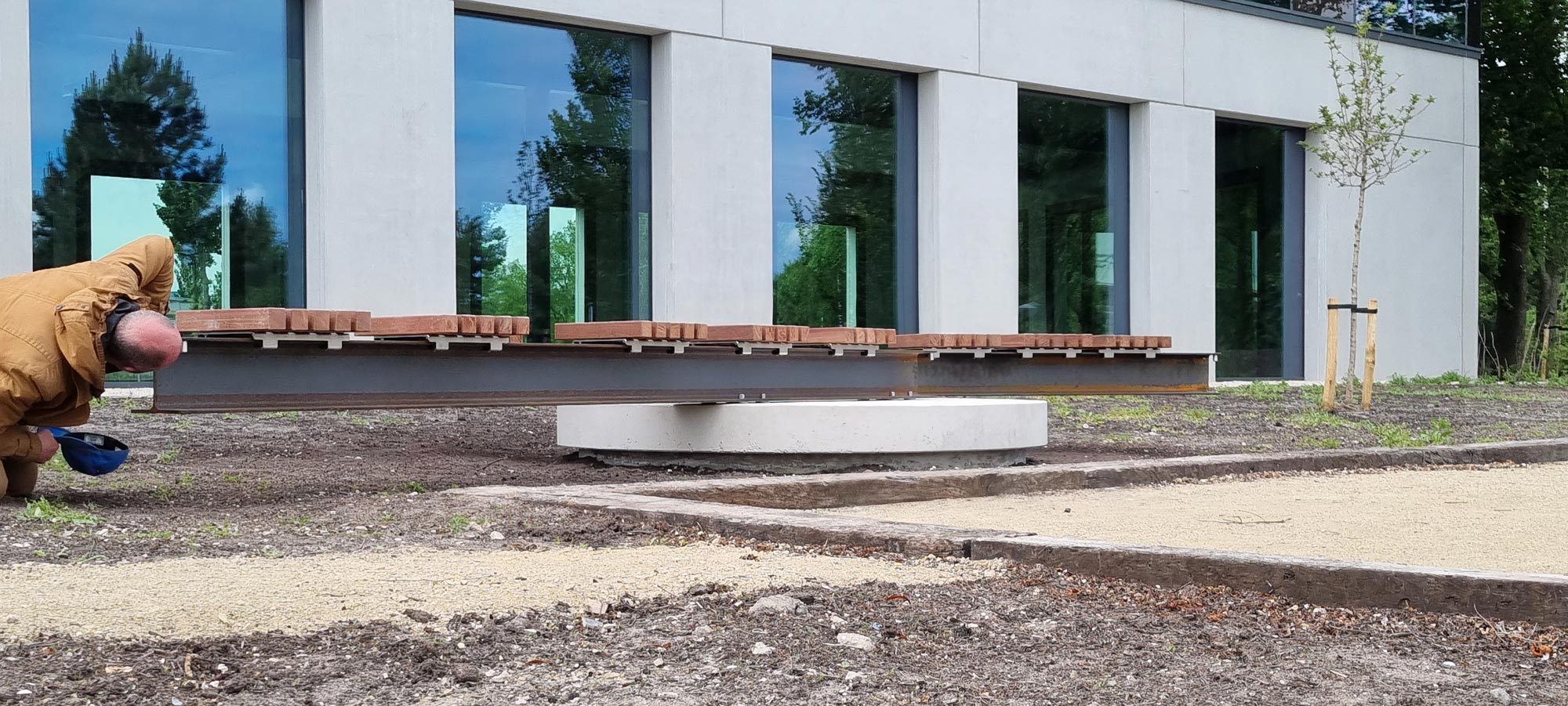
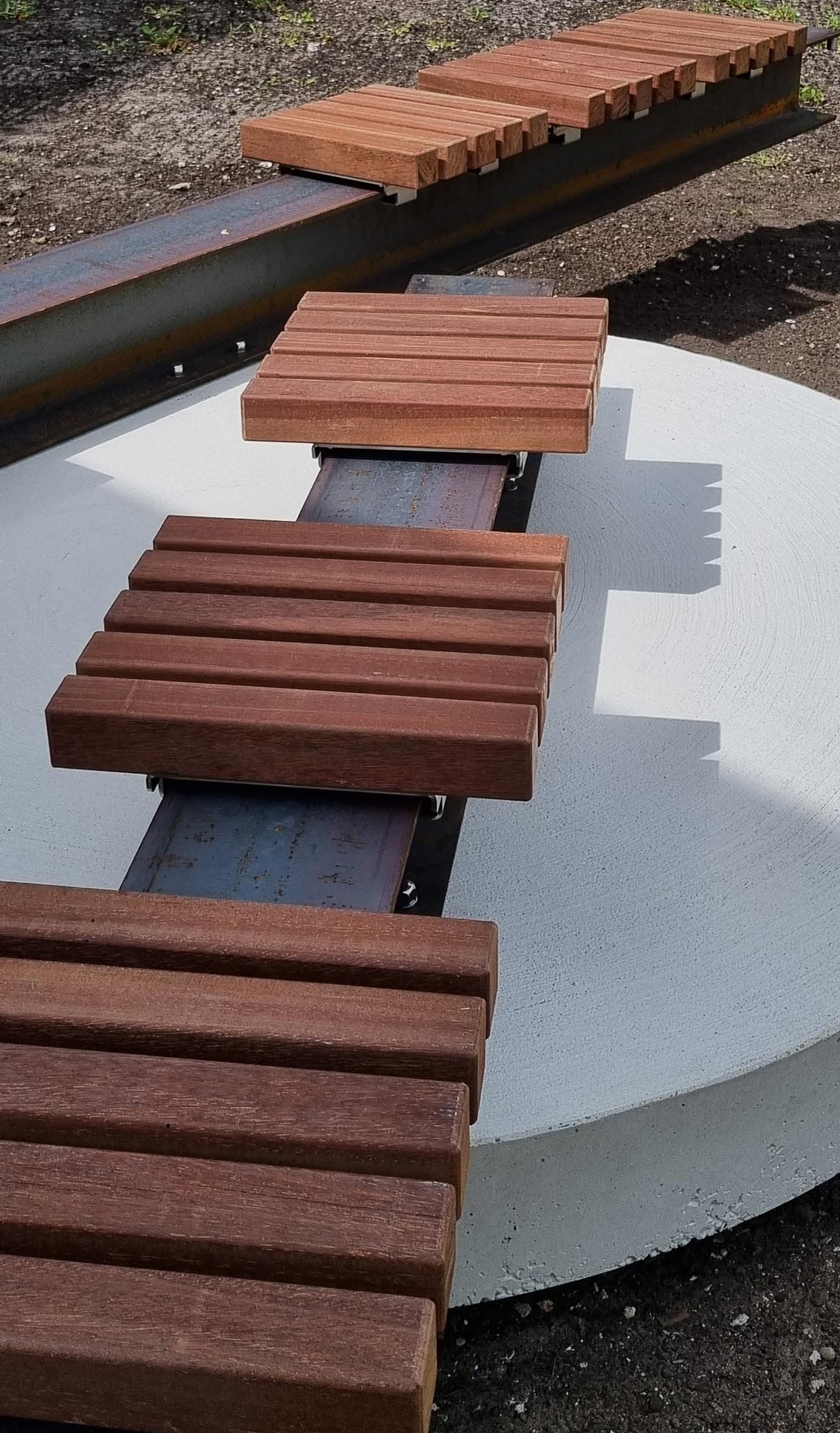

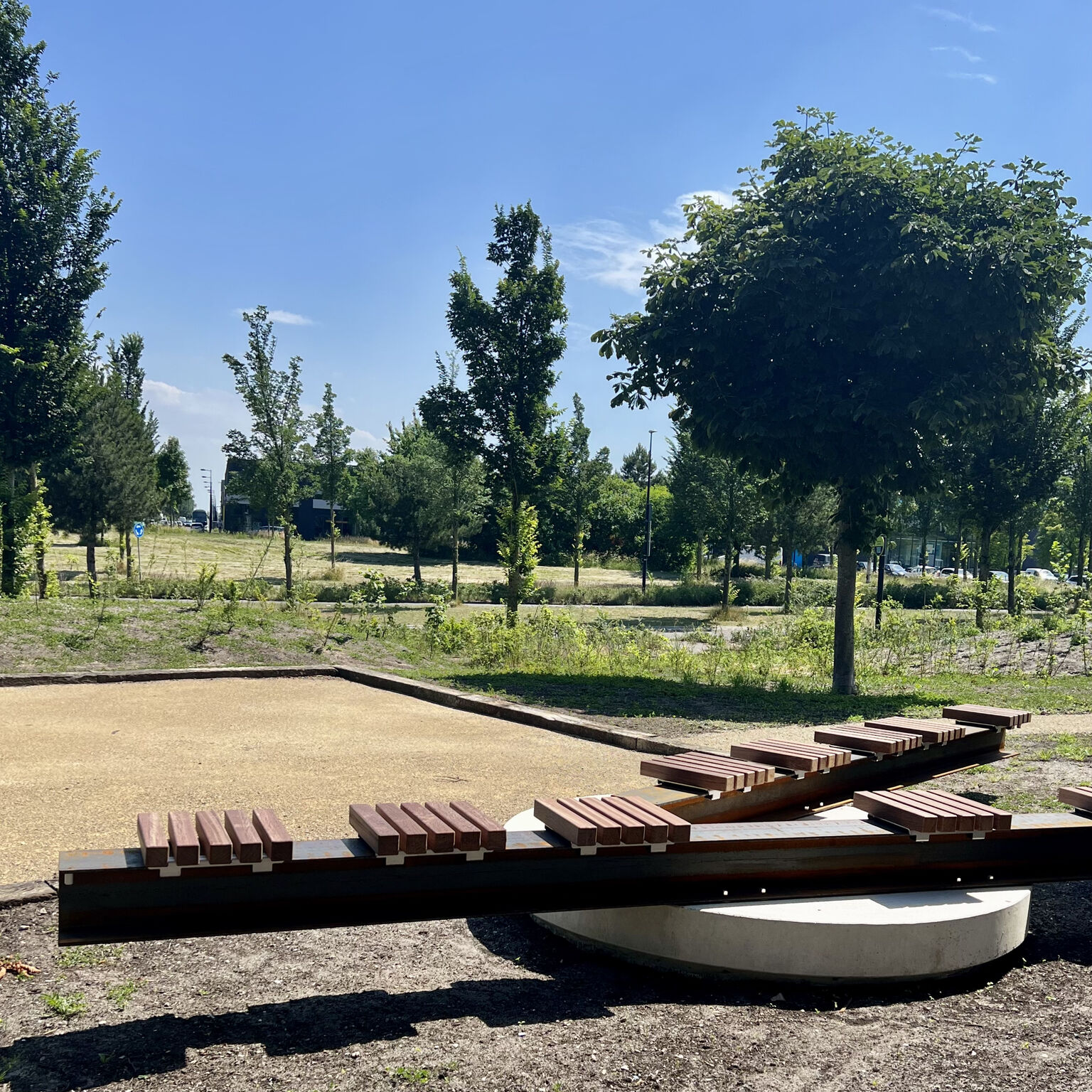
Design & production / Bygg Architecture & Design:
Raphaël Coutin, Ivo Hulskamp
Special thanks to Martynas Gailiušas
Year: 2022
Location: Disketteweg, Amsterdam
Client: Being
CD-One is the name given to a new office building in the north of Amsterdam.
In 2022, with the completion of the building, Bygg was asked to design a seating element to be placed next to a jeu de boules.
The surrounding area used to be highly industrial with large shipyards, steel factories... For a few decades already, the area is in constant transformation, the industry has moved elsewhere and more service-based companies, small studios started arriving.
In the neighborhood the streets are named after computer themes; disketteweg, Netwerkweg, Back-upstraat, binairstraat... With these two facts in mind, Ivo & Raphael created a concrete disk, engraved like an LP vinyl record, on which two industrial steel beam come to rest.
On top, ten wooden seats can slide along and adjust to any seating configuration. One of the main concerns was to create a piece that can age well in an outdoor environment. This is the reason we choose these materials, the steel beam will rust but by floating on a few stainless steel rings it will not affect the concrete. Furthermore, we used durable hardwood mounted on a stainless steel frame.
In 2022, with the completion of the building, Bygg was asked to design a seating element to be placed next to a jeu de boules.
The surrounding area used to be highly industrial with large shipyards, steel factories... For a few decades already, the area is in constant transformation, the industry has moved elsewhere and more service-based companies, small studios started arriving.
In the neighborhood the streets are named after computer themes; disketteweg, Netwerkweg, Back-upstraat, binairstraat... With these two facts in mind, Ivo & Raphael created a concrete disk, engraved like an LP vinyl record, on which two industrial steel beam come to rest.
On top, ten wooden seats can slide along and adjust to any seating configuration. One of the main concerns was to create a piece that can age well in an outdoor environment. This is the reason we choose these materials, the steel beam will rust but by floating on a few stainless steel rings it will not affect the concrete. Furthermore, we used durable hardwood mounted on a stainless steel frame.
Join The Stage



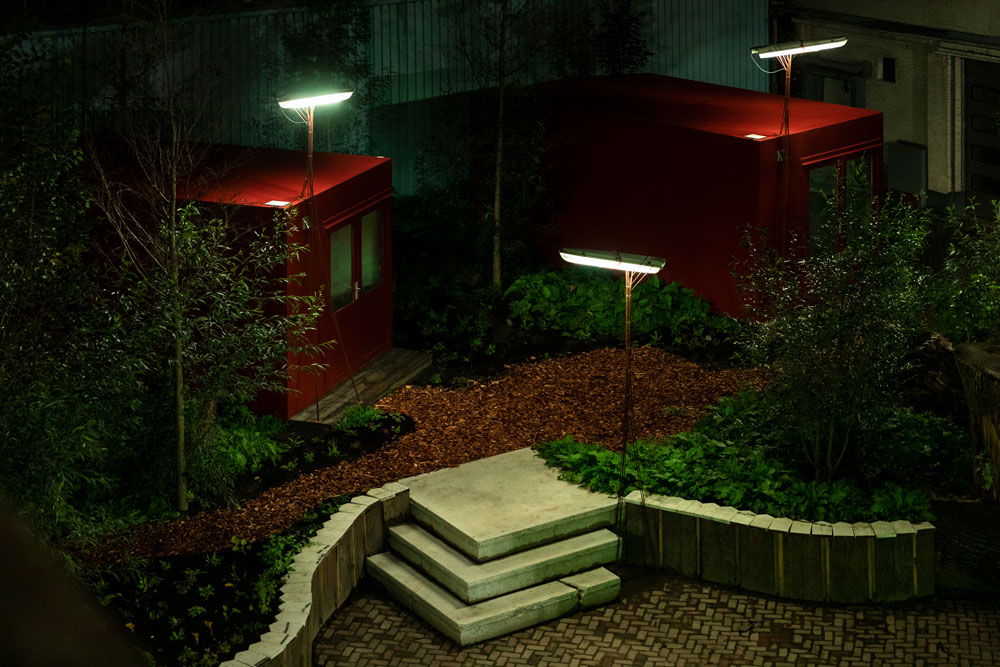

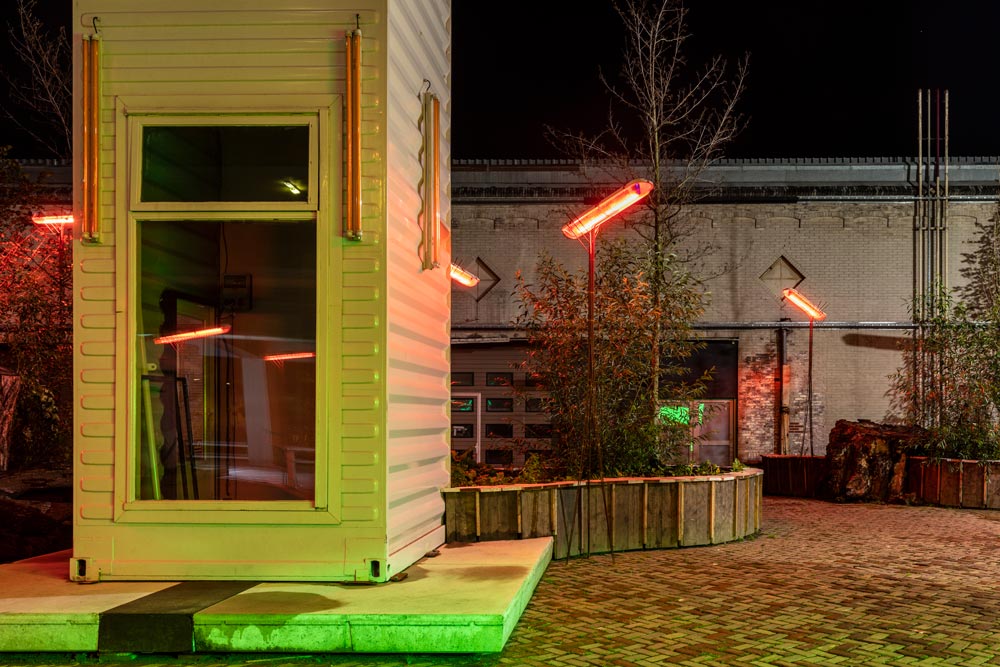
Design & production / Bygg Architecture & Design & NulZes
Landscape / Tom van Duuren
Picture /Barbara Medo
Date/ 2020 - ongoing
Location/ VDMA, Eindhoven
Client/ Being
Size/ 800m2
Join the stage is the platform for dialogue between past - present and future of VDMA Eindhoven In the coming years, the whole area will be re-developed into a new part of the city, where people will live, work and recreate.
Together, NulZes and Bygg designed the temporary stage of this big development, using the momentum in between, lost in transition, to accompany and question the impact on the local scale of an urban transformation. We want to involve residents and visitors in this process of area development. How does a city come about? How is a place created where people feel welcome? How do you create a resilient neighborhood where residents take responsibility? Which can withstand unexpected developments?
Our temporary intervention in this inner courtyard introduces some elements of the final development such as the forest, but also creates a platform: a stage to give voices to local initiative in dialogue with the new plan. In this little forest we have placed a bar, The Vertical Gallery, 2 cabins in the wood, a cabin for the forest watcher and a light installation in the whole area.
We believe, feeling connected to a place is a key element for any development. (That is the reason, we as Eindhoven residents and neighbors are participating in this project). Personal and collective memories that color the place. We want to take visitors to the stories of this rich past; about the match factory, where the name Lichtstad comes from, about the Garage, where Piet van der Meulen (the VDM of VDMA) ran the largest car garage in the Netherlands. But also about more recent history: where Feelgood Markets were organized, where Dave Hakkens and an army of creatives have collected plastic and transformed it into new material, where temporary interventions such as exhibitions and parties kept the place alive. Stories that formed the raw material for the plan that has been developed in recent years: Join the Stage
Together, NulZes and Bygg designed the temporary stage of this big development, using the momentum in between, lost in transition, to accompany and question the impact on the local scale of an urban transformation. We want to involve residents and visitors in this process of area development. How does a city come about? How is a place created where people feel welcome? How do you create a resilient neighborhood where residents take responsibility? Which can withstand unexpected developments?
Our temporary intervention in this inner courtyard introduces some elements of the final development such as the forest, but also creates a platform: a stage to give voices to local initiative in dialogue with the new plan. In this little forest we have placed a bar, The Vertical Gallery, 2 cabins in the wood, a cabin for the forest watcher and a light installation in the whole area.
We believe, feeling connected to a place is a key element for any development. (That is the reason, we as Eindhoven residents and neighbors are participating in this project). Personal and collective memories that color the place. We want to take visitors to the stories of this rich past; about the match factory, where the name Lichtstad comes from, about the Garage, where Piet van der Meulen (the VDM of VDMA) ran the largest car garage in the Netherlands. But also about more recent history: where Feelgood Markets were organized, where Dave Hakkens and an army of creatives have collected plastic and transformed it into new material, where temporary interventions such as exhibitions and parties kept the place alive. Stories that formed the raw material for the plan that has been developed in recent years: Join the Stage